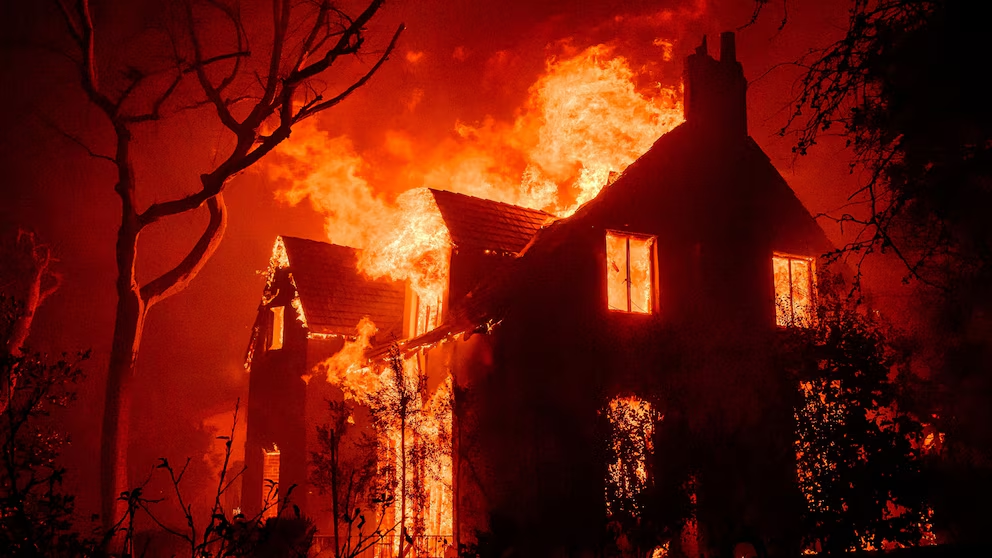A devastating wildfire erupted in the Pacific Palisades neighborhood of Los Angeles, forcing the evacuation of approximately 30,000 residents as powerful Santa Ana winds fueled the blaze. The fire, which has consumed nearly 3,000 acres and remains uncontained, has destroyed homes, disrupted power for hundreds of thousands, and raised alarms over potential cultural and environmental losses.
Unprecedented Wind Conditions Amplify Fire Spread
The wildfire, which started late on January 7, was quickly propelled by Santa Ana winds gusting up to 100 mph. These hurricane-level winds created perfect conditions for the fire to spread uncontrollably across the dry vegetation in the region. Firefighters on the ground are battling the flames, but aerial firefighting operations have been grounded due to the dangerous wind conditions.
“This is one of the most challenging wildfire scenarios we’ve faced in recent memory,” said Los Angeles Fire Department (LAFD) Chief Kristin Crowley. “The winds are making it nearly impossible to contain the flames, and we’re asking the public to comply with evacuation orders for their safety.”
Evacuations and Community Impact
Mandatory evacuation orders have been issued for Pacific Palisades, Malibu, and portions of Santa Monica. Affluent neighborhoods in these areas have been hit particularly hard, with several multimillion-dollar homes reduced to ash. Evacuation centers have been set up across Los Angeles County to accommodate displaced residents.
Among the landmarks at risk is the Getty Villa Museum, a renowned cultural site. While the fire has reached the museum’s grounds, firefighters are working tirelessly to protect the structure. “The Getty Villa is an irreplaceable treasure, and we’re doing everything we can to save it,” said one firefighter on the scene.
The wildfire has also led to the closure of schools and public facilities, further disrupting daily life in Los Angeles. Power outages have affected over 200,000 residents, leaving many without electricity as temperatures in the area drop overnight.
Celebrities and High-Profile Evacuations
The fire has forced evacuations of several high-profile individuals, including celebrities like Spencer Pratt and Heidi Montag. The couple fled their Pacific Palisades home, which was later destroyed by the flames. Social media has been flooded with posts from residents and public figures documenting their evacuation experiences and expressing gratitude for the efforts of first responders.
“This fire is a nightmare,” Montag wrote on social media. “We’re devastated to lose our home, but we’re thankful to be safe.”
Emergency Response and State of Emergency
Governor Gavin Newsom has declared a state of emergency in response to the wildfire crisis. Over 1,400 firefighters have been deployed to combat the blaze, with reinforcements arriving from neighboring counties. Despite their efforts, the fire remains 0% contained as of this report.
“We’re throwing every resource we have at this fire,” said Governor Newsom in a press briefing. “Our top priority is protecting lives and property while ensuring the safety of our firefighters on the frontlines.”
Warnings from Officials
The National Weather Service has issued warnings that the dangerous fire conditions are expected to persist for the next 48 hours. The combination of strong winds, low humidity, and dry vegetation poses a continuing threat to the region. Officials have urged residents in surrounding areas to remain prepared for potential evacuation orders.
“We can’t emphasize enough how critical it is for everyone to stay informed and follow instructions from emergency personnel,” said Chief Crowley. “Lives are at stake.”
Public Response and Volunteer Efforts
The Los Angeles community has rallied to support those affected by the wildfire. Local organizations are collecting donations of food, water, and essential supplies for evacuees. Volunteers are working at evacuation centers to provide comfort and assistance to displaced families.
“We’ve seen an incredible outpouring of support from the community,” said Maria Lopez, a volunteer at a local shelter. “In times like these, it’s heartening to see people come together to help one another.”
Environmental and Long-Term Impact
The wildfire’s environmental impact is expected to be significant, with local ecosystems and wildlife habitats severely affected. Additionally, the financial toll on residents and the state is likely to be substantial. Early estimates suggest that damages could run into the hundreds of millions of dollars.
Experts warn that this wildfire is a stark reminder of the increasing frequency and intensity of wildfires in California due to climate change. “We’re seeing fires burn faster and hotter than ever before,” said Dr. Sarah Thompson, a climate scientist. “It’s a trend that underscores the urgent need for wildfire prevention and climate adaptation strategies.”
What’s Next?
As firefighters continue to battle the flames, residents are being urged to monitor updates from local authorities and news outlets. Evacuation orders are being enforced strictly to ensure public safety, and those in affected areas are advised to prepare emergency kits and plans.
For now, the Pacific Palisades wildfire serves as a sobering reminder of the challenges posed by California’s wildfire season. With communities displaced, cultural landmarks at risk, and firefighters facing immense challenges, the region is bracing for what could be a long and arduous recovery.
Residents can find updates on evacuation routes, shelter locations, and safety measures through the LAFD and county emergency management websites. The public is also encouraged to support relief efforts for those affected by the fire.

